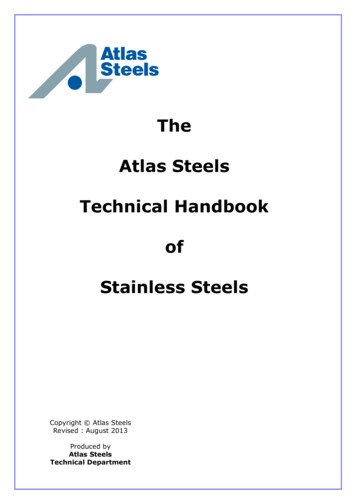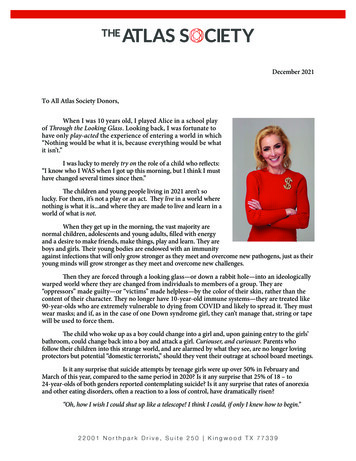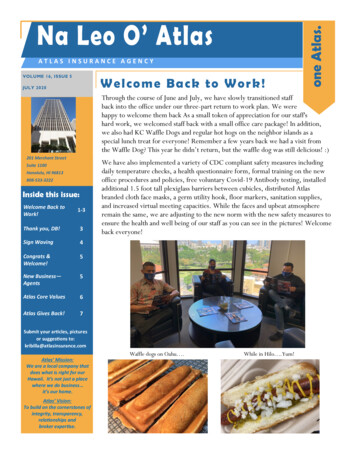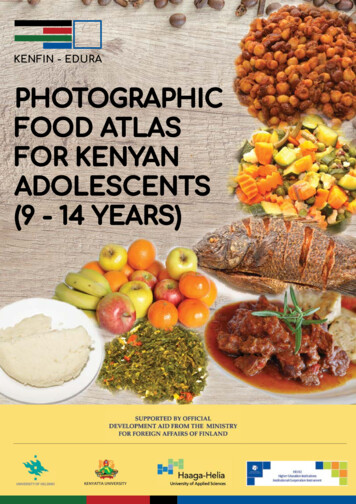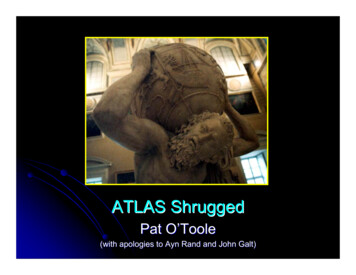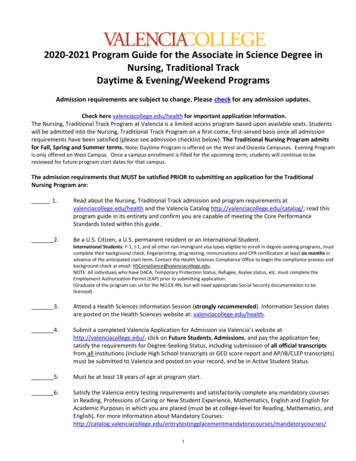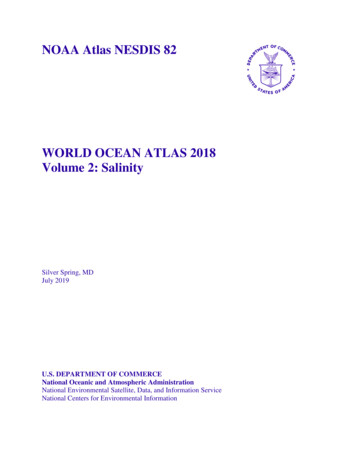
Transcription
NOAA Atlas NESDIS 82WORLD OCEAN ATLAS 2018Volume 2: SalinitySilver Spring, MDJuly 2019U.S. DEPARTMENT OF COMMERCENational Oceanic and Atmospheric AdministrationNational Environmental Satellite, Data, and Information ServiceNational Centers for Environmental Information
NOAA National Centers forEnvironmental InformationAdditional copies of this publication, as well as informationabout NCEI data holdings and services, are available uponrequest directly from NCEI.NOAA/NESDISNational Centers for Environmental InformationSSMC3, 4th floor1315 East-West HighwaySilver Spring, MD 20910-3282Telephone:E-mail:WEB:(301) /For updates on the data, documentation, and additionalinformation about the WOA18 please refer to:http://www.nodc.noaa.gov/OC5/indprod.htmlThis document should be cited as:Zweng, M.M, J.R. Reagan, D. Seidov, T.P. Boyer, R.A. Locarnini, H.E. Garcia, A.V. Mishonov,O.K. Baranova, K.W. Weathers, C.R. Paver, and I.V. Smolyar (2019). World Ocean Atlas 2018,Volume 2: Salinity. A. Mishonov, Technical Editor, NOAA Atlas NESDIS 82, 50pp.This document is available on line at http://www.nodc.noaa.gov/OC5/indprod.html
NOAA Atlas NESDIS 82WORLD OCEAN ATLAS 2018Volume 2: SalinityMelissa M. Zweng, James R. Reagan, Dan Seidov, Timothy P. Boyer,Ricardo A. Locarnini, Hernan E. Garcia, Alexey V. Mishonov, Olga K.Baranova, Katharine W. Weathers, Christopher R. Paver, Igor V. SmolyarTechnical Editor: Alexey MishonovOcean Climate LaboratoryNational Centers for Environmental InformationSilver Spring, MarylandJuly 2019U.S. DEPARTMENT OF COMMERCEWilbur L. Ross, SecretaryNational Oceanic and Atmospheric AdministrationNeil Jacobs, Assistant Secretary of Commerce for EnvironmentalObservations and PredictionActing Under Secretary of Commerce for Oceans and AtmosphereNational Environmental Satellite, Data and Information ServiceStephen Volz, Assistant Administrator
To Sydney (Syd) LevitusSyd exemplifies the craft ofcareful, systematic inquiry of the largescale distributions and low-frequencyvariability from seasonal-to-decadaltime scales of ocean properties. He wasone of the first to recognize theimportance and benefits of creatingobjectively analyzed climatologicalfields of measured ocean variablesincludingtemperature,salinity,oxygen, nutrients, and derived fieldssuch as mixed layer depth. Uponpublishing Climatological Atlas of theWorld Ocean in 1982, he distributedthis work without restriction, an act not common at the time. This seminal atlas moved theoceanographic diagnostic research from using hand-drawn maps to using objectively analyzedfields of ocean variables.With his NODC Ocean Climate Laboratory (OCL) colleagues, and unprecedentedcooperation from the U.S. and international ocean scientific and data management communities,he created the World Ocean Database (WOD); the world’s largest collection of ocean profile datathat are available internationally without restriction. The World Ocean Atlas (WOA) seriesrepresents the gridded objective analyses of the WOD and these fields have also been madeavailable without restriction.The WOD and WOA series are used so frequently that they have become knowngenerically as the “Levitus Climatology”. These databases and products enable systematic studiesof ocean variability in its climatological context that were not previously possible. His foresight increating WOD and WOA has been demonstrated by their widespread use over the years. Syd hasmade major contributions to the scientific and ocean data management communities. He has alsoincreased public understanding of the role of the oceans in climate. He retired in 2013 after 39years of distinguished civil service. He distilled the notion of the synergy between rigorous datamanagement and science; there are no shortcuts.All of us at the Ocean Climate Laboratory would like to dedicate this atlas to Syd, hislegacy, vision, and mentorship.The OCL team members
Table of ContentsTABLE OF CONTENTS . ILIST OF FIGURES . ILIST OF TABLES .IILIST OF ACRONYMS .IIPREFACE . IVACKNOWLEDGMENTS . VABSTRACT .11. INTRODUCTION .12. DATA SOURCES AND DATA DISTRIBUTION .22.1. DATA SOURCES .22.2. DATA QUALITY CONTROL .32.2.1. Duplicate elimination .42.2.2. Range and gradient checks .42.2.3. Statistical checks .42.2.4. Static stability check.52.2.5. Subjective flagging of data .62.2.6. Representativeness of the data .62.2.7. XCTD drop-rate error correction .63. DATA PROCESSING PROCEDURES .73.1. VERTICAL INTERPOLATION TO STANDARD LEVELS .73.2. METHODS OF ANALYSIS .73.2.1. Overview .73.2.2. Derivation of Barnes (1964) weight function .93.2.3. Derivation of Barnes (1964) response function . 103.2.4. Choice of response function . 113.2.5. First-guess field determination . 123.3. CHOICE OF OBJECTIVE ANALYSIS PROCEDURES. 133.4. CHOICE OF SPATIAL GRID . 133.4.1 Increased Spatial Resolution . 133.5. STABILIZATION OF TEMPERATURE AND SALINITY CLIMATOLOGIES . 144. RESULTS . 154.1. COMPUTATION OF ANNUAL AND SEASONAL FIELDS . 164.2. AVAILABLE STATISTICAL FIELDS . 164.3 OBTAINING WOA18 FIELDS ONLINE . 165. SUMMARY . 176. FUTURE WORK . 177. REFERENCES . 178. APPENDICES . 308.1. APPENDIX A: STABILIZATION OF TEMPERATURE AND SALINITY CLIMATOLOGIES . 308.2. APPENDIX B: EXAMPLE OF STABILIZATION . 358.3 APPENDIX C: GEOGRAPHIC SALINITY LIMITATIONS . 41List of FiguresFigure 1. The annual salinity of the California Current at 30m depth for the 1955 - 1964 decade as represented byone-degree resolution and quarter-degree resolution. . 15Figure 2. Response function of the WOA18, WOA13, WOA09, WOA05, WOA01, WOA98, WOA94, and Levitus(1982) objective analysis schemes. . 28Figure 3. Scheme used in computing “all-data” annual, seasonal, and monthly objectively analyzed means forsalinity. . 29i
List of TablesTable 1. Radii of influence used in the objective analysis for the one-degree and quarter-degree climatologies. . 14Table 2. Descriptions of climatologies for salinity. The standard depth levels are shown in Table 4. . 22Table 3. Descriptions of datasets in WOD18. 22Table 4. Acceptable distances (m) for defining interior (A) and exterior (B) values used in the Reiniger-Rossscheme for interpolating observed level data to standard levels. . 23Table 5. Response function of the objective analysis scheme as a function of wavelength for WOA18 and earlieranalyses. Response function is normalized to 1.0. . 25Table 6. Basins defined for objective analysis and the shallowest standard depth level for which each basin isdefined. 26Table 7. Statistical fields calculated as part of WOA18 Salinity . 27Table B1. Gridbox 171.5 E, 53.5 S improved WOA98 profiles before stabilization. . 39Table B2. Gridbox 171.5 E, 53.5 S improved WOA98 profiles after stabilization. . 40List of TSLDEOMASTMBTMEDARMRBNAONASANATONCEINESDISExpanded TermAutonomous Pinniped BathythermographBulletin of the American Meteorological SocietyComma-Separated ValueConductivity Temperature DepthDrifting BathythermographDepartment of CommerceDepartment of EnergyDrifting BuoyEl Niño-Southern OscillationEarth Research LaboratoryEarth Topography 2 arc minuteExtended Vertical ResolutionGeographic Information SystemGliderGreenwich Mean Time, or Generic Mapping ToolsGlobal Ocean Data Archaeology and RescueGlobal Temperature-Salinity Profile ProgramInternational Association for the Physical Sciences of the OceansInternational Oceanographic CommissionInternational Oceanographic Data ExchangeInternational Research Institute for Climate and SocietyJapan Agency for Marine-Earth Science and TechnologyJoint Panel on Oceanographic Tables and StandardsLamont-Doherty Earth ObservatoryMarine Science and TechnologyMechanical BathythermographMediterranean Data Archeology and RescueMoored BuoyNorth Atlantic OscillationNational Aeronautics and Space AdministrationNorth Atlantic Treaty OrganizationNational Centers for Environmental InformationNational Environmental Satellite, Data, and Information Serviceii
/TRITONTSKUNESCOUORUSAUSNWDSWOAWODXBTXCTDExpanded TermNational Oceanic and Atmospheric AdministrationNational Ocean Data CenterOcean Climate LaboratoryOcean Data ViewProfiling FloatPrediction and Research Moored Array in the Tropical AtlanticPractical Salinity ScaleResearch Moored Array for African-Asian-Australian Monsoon Analysis and PredictionRear AdmiralSea Surface TemperatureSurfaceTropical Atmosphere Ocean moored buoy arrayTsurumi-Seiki CompanyUnited Nations Educational, Scientific and Cultural OrganizationUndulating Oceanographic RecorderUnited States of AmericaUnited States NavyWorld Data ServiceWorld Ocean AtlasWorld Ocean DatabaseExpendable BathythermographExpendable Conductivity Temperature Depthiii
PrefaceThe World Ocean Atlas 2018 (WOA18) is the latest in a line of oceanographic analyses ofsubsurface ocean variables at standard depths extending back to the groundbreakingClimatological Atlas of the World Ocean (Levitus, 1982). The WOA has been published semiregularly since 1994, with versions in 1998, 2001, 2005, 2009, 2013, and now 2018. Previousiterations of the WOA have proven to be of great utility to the oceanographic, climate research,geophysical, and operational environmental forecasting communities. The oceanographic variableanalyses are used as boundary and/or initial conditions in numerical ocean circulation models andatmosphere-ocean models, for verification of numerical simulations of the ocean, as a form of "seatruth" for satellite measurements such as altimetric observations of sea surface height, forcomputation of nutrient fluxes by Ekman transport, and for planning oceanographic expeditionsamong others.WOA18 includes analyses on a one-degree grid for all variables and on a quarter-degree grid fortemperature and salinity. Since WOA13, the ocean variable analyses are produces on 102 depthlevels from the surface to 5,500 m (previously 33 levels within the same depth limits). Oceandata and analyses of data at higher vertical resolution than previously available are needed todocument the variability of the ocean, including improving diagnostics, understanding, andmodeling of the physics of the ocean.In the acknowledgment section of this publication, we have expressed our view that creation ofglobal ocean profile and plankton databases and analyses are only possible through the cooperationof scientists, data managers, and scientific administrators throughout the international scientificcommunity.A pre-release version of WOA18 was made available in September, 2018. The final version ofWOA18 was released in July, 2019. In the interim community feedback and our own work hasled to changes in the temperature atlas in particular. Animal mounted pinniped temperatureprofiles have been added as a data source improving coverage in some high latitude areas. Adifferent Expendable Bathythermograph (XBT) correction (Cheng et al., 2014) has beenemployed. These changes are detailed below. Also, the XBTs were doubly corrected in the prerelease version. The Levitus correction was applied after another correction had been applied(Cheng et al., 2014). This error led to an ocean which was less than 0.1 C cooler in the pre-releaseWOA18 as compared to the final WOA18 for the most affected decades (1975-84, 1985-94, 19952004) in the upper 400m with smaller differences below. The 1981-2010 climate normal fortemperature is slightly cooler ( 0.05 C) in the final WOA18 than in the pre-release WOA18 dueto inadvertent double-weighting of the 2001-2010 decade in the pre-release version.Ocean Climate Laboratory TeamNational Centers for Environmental InformationSilver Spring, MDJuly 2019iv
AcknowledgmentsThis work was made possible by a grant from the NOAA Climate and Global Change Program,which enabled the establishment of a research group at the National Oceanographic Data Center(now the National Centers for Environmental Information – NCEI). The purpose of this group isto prepare research quality oceanographic databases, as well as to compute objective analyses of,and diagnostic studies based on, these databases. Support is now from base funds and from theNOAA Climate Program Office.The data on which this atlas is based are in World Ocean Database 2018 and are distributed online by NCEI. Many data were acquired as a result of the IOC/IODE Global Oceanographic DataArchaeology and Rescue (GODAR) project, and the IOC/IODE World Ocean Database project(WOD).The WOD is a composite of publicly available ocean profile data, both historical and recent. Weacknowledge the scientists, technicians, and programmers who have collected and processed data,those individuals who have submitted data to national and regional data centers as well as themanagers and staff at the various data centers. We are working on a more substantive andformalized way to acknowledge all those who have collected and contributed to oceanographicmeasurements, which were used to calculate the fields in the WOA. Until we have such a systemin place, we direct the reader’s attention to lists of primary investigators, institutions, and projects,which contributed data (codes can be used to locate data in the World Ocean Database). We alsothank our colleagues at the NCEI. Their efforts have made this and similar works possible.We thank the thoughtful reviewers whose comments greatly improved this manuscript: ChristopheMaes (Institut de recherche pour le développement, Brest, France) and Yongsheng Zhang (NOAANational Centers for Environmental Information, Silver Spring, Maryland, USA).We dedicate this work to Carla Coleman who alwayscontributed with a smile and was taken from us too soon.v
WORLD OCEAN ATLAS 2018Volume 2: SalinityABSTRACTThis atlas consists of a description of data analysis procedures and horizontal maps ofclimatological distribution fields of salinity at selected standard depth levels of the World Oceanon a one-degree and quarter-degree latitude-longitude grids. The aim of the maps is to illustratelarge-scale characteristics of the distribution of ocean salinity. The fields used to generate theseclimatological maps were computed by objective analysis of all scientifically quality-controlledhistorical salinity data in the World Ocean Database 2018. Maps are presented for climatologicalcomposite periods (annual, seasonal, monthly, seasonal and monthly difference fields from theannual mean field, and the number of observations) at 102 standard depths.annual “all-data” climatology was calculatedusing observations from all months of allyears. Seasonal “all-data” climatologieswere calculated using only data from thedefined season (regardless of year). Theseasons are defined as follows: Winter isdefined as January, February, and March;spring as April, May, and June; summer asJuly, August, and September; and fall asOctober, November, and December. Monthly“all-data” climatologies were calculatedusing data only from the given month.1. INTRODUCTIONThis atlas is part of the World Ocean Atlas2018 (WOA18) series. The WOA18 seriesincludes analysis for temperature (Locarniniet al., 2019); salinity (this atlas); dissolvedoxygen (Garcia et al., 2019a); and dissolvedinorganic nutrients (Garcia et al., 2019b).This atlas presents annual, seasonal, andmonthly climatologies and related statisticalfields for salinity. Climatologies in this atlasare defined as mean oceanographic fields atselected standard depth levels based on theobjectiveanalysisofhistoricaloceanographic profiles and select surfaceonly data. A profile is defined as a set ofmeasurements for a single variable(temperature, salinity, etc.) at discrete depthstaken as an instrument drops or risesvertically in the water column. Temperatureand salinity climatologies are the average ofsix “decadal” climatologies for the followingtime periods: 1955-1964, 1965-1974, 19751984, 1985-1994, 1995-2004, and 20052017, as well as a “climate normal” period1981-2010 as defined by the WorldMeteorological Organization (WMO, 2017).Oxygen and nutrients climatologies use allavailable data regardless of the year of itsobservation (“all-data” climatology). TheThe salinity data used are available from theNational Oceanographic Data Center (NCEI)and World Data Service (WDS) forOceanography, Silver Spring, Maryland.Large volumes of data have been acquired asa result of the fulfillment of several datamanagement projects including:a) the Intergovernmental OceanographicCommission (IOC) GlobalOceanographic Data Archaeology andRescue (GODAR) project (Levitus etal., 2005);b) the IOC World Ocean Database project(WOD);c) the IOC Global Temperature SalinityProfile project (GTSPP) (IOC, 1998).1
The salinity data used in the WOA18 havebeen analyzed in a consistent, objectivemanner on one-degree and quarter-degreelatitude-longitude grids at standard depthlevels from the surface to a maximum depthof 5500m. The procedures for “all-data”climatologies are identical to those used inthe World Ocean Atlas 2013 (WOA13) series(Johnson et al., 2013, Locarnini et al. 2013,Zweng et al., 2013), World Ocean Atlas 2009(WOA09) series (Locarnini et al., 2010;Antonov et al., 2010; Garcia et al. 2010 a, b),World Ocean Atlas 2005 (WOA05) series(Locarnini et al., 2006; Antonov et al., 2006;Garcia et al. 2006 a, b), the World OceanAtlas 2001 (WOA01) series (Stephens et al.,2002; Boyer et al., 2002; Locarnini et al.,2002; Conkright et al., 2002) and WorldOcean Atlas 1998 (WOA98) series (Antonovet al., 1998 a, b, c; Boyer et al., 1998 a, b, c;Conkright et al., 1998, a, b, c; O’Brien et al.,1998, a, b, c). Slightly different procedureswere followed in earlier analyses (Levitus,1982; World Ocean Atlas 1994 series[WOA94, Levitus et al., 1994; Levitus andBoyer 1994a, b; Conkright et al., 1994]).WOA13 differed from WOA09 by increasingthe number of standard levels used from 33to 102, increasing the resolution with depth;WOA18 continues to use the same 102 depthlevels as WOA13.season, thus precluding any representativeannual analysis. In some areas there may be areasonable spatial distribution of data pointson which to base an analysis, but there maybe only a few (perhaps only one) data valuesin each one-degree latitude-longitude square.Objective analyses shown in this atlas arelimited by the nature of the salinity database(data are non-uniform in both space andtime), characteristics of the objective analysistechniques, and the grid used. The primarylimitation of the analysis is data coverage inspace and time. Since the publication ofWOA13, substantial amounts of additionalhistorical salinity data have becomeavailable.However, even with theseadditional data, we are still hampered in anumber of ways by a lack of data. In someareas, quality control is made difficult by thelimited number of data collected in theseareas. Data may exist in an area for only one2.1. Data sourcesThis atlas is divided into sections. We beginby describing the data sources and datadistribution (Section 2). Then we describethe general data processing procedures(Section 3), the results (Section 4), summary(Section 5), and future work (Section 6).After the references (Section 7), theappendices of this atlas (Section 8) includedescriptions and examples of the stabilizationof the temperature and salinity climatologies.Maps for each individual depth level for eachtime period are available online.2. DATA SOURCES AND DATADISTRIBUTIONData sources and quality control proceduresare briefly described below. For furtherinformation on the data sources used inWOA18 refer to the World Ocean Database2018 (WOD18, Boyer et al., 2019). Thequality control procedures used inpreparation of these analyses are describedby Garcia et al. (2019a).Historical oceanographic salinity profile mperature-Depth(CTD)packages, profiling floats, moored anddrifting buoys, gliders, and undulatingoceanographic recorder (UOR) profiles usedin this project were obtained from theNCEI/WDS archives and include all datagathered as a result of the GODAR and WODprojects.An important source of salinity data is shipmounted thermosalinographs, which measuresurface temperature and salinity as ships2
standard depths (see section 3.1 for details).The levels at which the climatologies werecalculated are given in Table 2. Table 3describes the datasets used to calculate theclimatologies. Table 4 shows the depths ofeach standard depth level.transit the ocean. The primary focus of WODand WOA is profile and subsurface data, butwe have included some thermosalinographdata as part of the SUR (surface) dataset. Forfurther information, please see Chapter 14 ofthe WOD18 documentation (Boyer et al.,2019).2.2. Data quality controlTo understand the procedures for takingindividual oceanographic observations andconstructing climatological fields, it isnecessary to define the terms “standard leveldata” and “observed level data”. We refer tothe actual measured value of anoceanographic variable in situ as an“observation”, and to the depth at which sucha measurement was made as the “observedlevel depth.” We refer to such data as“observed level data.”Before thedevelopmentofoceanographicinstrumentation that measures at highfrequencies along the vertical profile,oceanographers often attempted to makemeasurements at selected “standard levels” inthe water column. Sverdrup et al. (1942)presented the suggestions of the InternationalAssociation for the Physical Sciences of theOceans (IAPSO) as to which depthsoceanographic measurements should bemade or interpolated to for analysis.Historically the World Ocean Atlas used amodified version of the IAPSO standarddepths. However, with the increased globalcoverage of high depth resolutioninstrumentation, such as profiling floats,WOA has extended the standard depth levelsfrom 33 to 102. The current standard depthlevels include the original depth levelspresented up to WOA09, but have tripled theresolution in the upper 100 meters, more thandoubled the depth resolution of the upper1000 meters, and almost three and a halftimes the resolution for overall depth levels.For many purposes, including preparation ofthe present climatologies, observed level dataare interpolated to standard depth levels ifobservations did not occur at the desiredQuality control of the salinity data is a majortask, the difficulty of which is directly relatedto lack of data and metadata (for some areas)upon which to base statistical checks.Consequently, certain empirical criteria wereapplied - see sections 2.2.1 through 2.2.4, andas part of the last processing step, subjectivejudgment was used - see sections 2.2.5 and2.2.6. Individual salinity data, and in somecases entire profiles or all profiles forindividual cruises, have been flagged and notused further because these data producedfeatures that were judged to be nonrepresentative or questionable. As part of ourwork, we have made available WOD18 thatcontains both observed levels profile data andstandard depth level profile data with variousquality control flags applied. The flags markeither individual measurements or entireprofiles that were not used in the next step ofthe procedure-- either interpolation tostandard depth levels for observed level dataor calculation of statistical means in the caseof standard depth level data.Constantly improving knowledge of theworld ocean variability now includes agreater appreciation and understanding of theubiquity of mesoscale features such aseddies, rings, and lenses in some parts of theworld ocean, as well as interannual andmulti-decadal variability of water massproperties associated with modal variabilityof the atmosphere such as the North AtlanticOscillation (NAO) and El Niño SouthernOcean Oscillation (ENSO). Some of thesefeatures, especially in the region with densedata coverage like, for example theNorthwest Atlantic Ocean, can find their way3
into high-resolution
DRB Drifting Buoy ENSO El Niño-Southern Oscillation ERL Earth Research Laboratory ETOPO2 Earth Topography 2 arc minute EVR Extended Vertical Resolution GIS Geographic Information System GLD Glider GMT Greenwich Mean Time, or Generic Mapping Tools GODAR Global Ocean Data Archaeology and Rescue

